Understanding the Empire State’s Criminal Justice System
 The court sides with concerned parents and Magdalena Garcia of the New York City Department of Health and Mental Hygiene.
The court sides with concerned parents and Magdalena Garcia of the New York City Department of Health and Mental Hygiene.
The mission of the New York State’s Department of Criminal Justice System (NYS DCJS) is to enhance public safety by providing resources and services that inform decision making and improve the quality of the criminal justice system. They define themselves as a “multi-function criminal justice support agency” with a number of core functions.
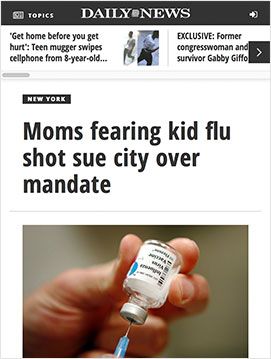 A group of concerned parents sued the state of New York over the policy of mandatory flu vaccinations. The case that began in 2015 was disposed as of June 2018.
A group of concerned parents sued the state of New York over the policy of mandatory flu vaccinations. The case that began in 2015 was disposed as of June 2018.
- They are responsible for training law enforcement.
- The NYS DCJ collects and analyses statewide crime data.
- They maintain criminal history information and personal information files.
- The DCJ is responsible for the processing of fingerprint-based criminal history background checks for employment and licensure.
- They provide administrative oversight for the state DNA databank.
- The DCJ accredits both forensic labs and police departments.
- They provide funding and oversight of the probation and municipal correctional programs.
- They hold administration over the federal and state criminal justice funds.
- They offer support for criminal justice-related agencies across the state.
- The DCJ holds administration over both state police and peace officer registries, and the state sex offender registry.
The NYS DCJS primarily serves as a resource for law enforcement professionals and those working in the criminal justice sector and public safety sector whom provide services for victims of crimes, offenders, and former offenders. The agency also serves the general public, and provides information to researchers and employees. Some such programs include Registered Sex Offender information, Criminal History Information, Criminal Justice Statistics and Information, and Security Guard Training.
There are three types of crimes that are defined by New York State law: felonies, misdemeanors, and violations.
-
I Typically known as the most serious type of crime, Felonies in New York State include crimes like murder, rape and arson. If found guilty, felony offenders may face at least one year in prison or jail, and more if appropriate for the severity of the crime. Because New York does not have a death penalty, the most severe punishment is life without parole. Felonies are divided into groups to indicate the seriousness of the crime.
- A-I felonies are violent, and carry a minimum 15 to 25 year imprisonment, and a maximum of life imprisonment without parole, except for drug crimes.
- A-II felonies are violent, and can also be punishable by life in prison, except for drug crimes, but the minimum sentencing is between three and eight years and four months. In the case of sexually predatory offenders, this can be raised to between 10 and 25 years.
- B&C felonies can be both violent and non-violent, and carry a minimum sentence of no less than one year and no more than 33 percent of the maximum term imposed on the given crime. The court is responsible for determining the actual time of imprisonment imposed within these parameters. These felonies usually involve violent assault, armed robbery, larceny, drug trafficking, or distribution, fraud, rape or alleged homicide.
- D&E felonies can be both violent and non-violent, and carry the same minimum sentencing rules as Class B&C felonies, with the possibility of an alternative sentencing. If the judge opts to use these alternative sentences, and once the nature of the crime and character of the offender has been revealed, they may choose to issue a sentence of under one year in prison. These felonies typically include abandonment of child, aggravated assault (upon a minor), arson through recklessness(4th degree arson), theft, fraud, burglary, and manslaughter.
-
II A misdemeanor is a less serious crime in New York, but more serious than a violation. The most that an offender can be punishable by, for even the most serious misdemeanors, is one year in prison. Common misdemeanors include graffiti tagging and prostitution. They are divided into three different categories.
- Class A misdemeanors are the most serious type of misdemeanors, but are still lightly punishable relative to felonies. Class A misdemeanors are punishable by up to one year in prison.
- Class B misdemeanors are punishable by up to 3 months in jail.
- Unclassified misdemeanors represent a wide category for misdemeanors, and are designated to crimes that do not fit into any other general category. The crimes they punish are often unique or subject to new laws or issues that have not yet been addressed. This can include gambling offenses, littering, or certain DWIs. They are typically punishable by up to three years of probation, but for certain crimes can be punished by up to one year in jail.
-
III Violations are the least serious type of crime in New York State and include crimes such as trespassing and disorderly conduct. The most someone can be punished for a violation is 15 days in jail.

New York state statutes provide for Indeterminate Sentencing, or sentencing that changes based on the seriousness of the crime. This allows more freedom for the judge involved in a case to fit the punishment to the crime that was committed, and may be more or less severe than the punishments specified in state legislation.
New York State’s court system is directed by The Court of Appeals in Albany, (unlike other states that are typically administered by a supreme court) which is the state’s highest court. It was established to “articulate statewide principles of law in the context of deciding particular lawsuits.” Because of this, the court tends to focus on broader issues as a means of establishing precedent, though will occasionally hear individual factual disputes. The amount of money being disputed in a civil case for the New York Court of Appeals is unlimited. Each of the seven justices that serve on The Court of Appeals is appointed to a 14-year term.

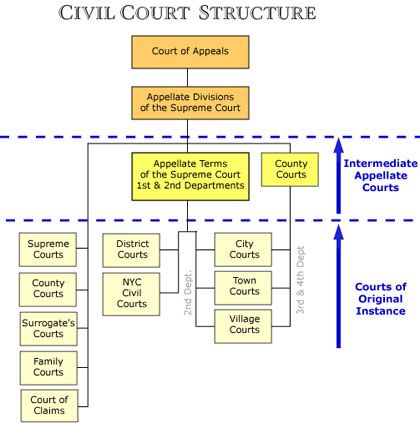
New York State’s court structure.
New York State’s courts are separated into both civil and criminal court structures, each with a three tier structure.
The criminal court
begins at with the courts of original instance; namely the 1,250 Town and Villages Courts (Justice Courts), the two city courts (Criminal and Civil Court), The NYC Criminal Court, District Court, County Courts, and Supreme Court. The second level of the criminal branch is the Appellate Divisions of the Supreme Court, the Appellate Terms of the Supreme Court 1st & 2nd Departments, and the Appellate level of the County Courts. Presiding over the criminal court system is the Albany-based Court of Appeals; New York State’s highest court.
The civil division
begins similarly, with Justice Courts, City Courts, District Courts, County Courts, and Supreme Court. This tier also includes the NYC Civil Courts, Surrogate’s Court, Family Courts, and the Court of Claims. The second tier also includes both the Appellate Terms of the Supreme Court 1st & 2nd Departments and the Appellate level of the County Courts. In the top tier, the only stop before New York State’s highest court is the Appellate Divisions of the Supreme Court. Once appealed from there, criminals appealing their case will be under the jurisdiction of the Court of Appeals.
 Mayor de Blasio of NYC signs legislation to provide low income New Yorkers with access to counsel for wrongful evictions.
Mayor de Blasio of NYC signs legislation to provide low income New Yorkers with access to counsel for wrongful evictions.
Courts in New York State hold regular business hours and observe holidays and terms of court when certain services may not be available. Be sure to plan any trip to your local courthouse accordingly.
The Court of Appeals established the Excellence Initiative in early 2016. Announced by Chief Justice Janet DiFiore just after her swearing in, the program provided a “detailed and comprehensive evaluation of current processes and procedures” as a means to determine what processes in the court system were succeeding and which were failing. One method employed by the NYS DCJS for gathering this information is by taking comments from citizens. These comments are submitted online, and may be submitted anonymously.
As New York City’s court system is the largest in the state, serving the most people, the Excellence Initiative focuses more on the five countries contained within the city, as well as the city courts themselves. The priorities of this initiative shift as needed, and as documented in the annual report for the Excellence Initiative, the priorities for 2018 in relation to New York City Criminal Courts are to resolve older DWI matters in Bronx County, and to support and observe Queens County’s two week “all-hands-on-deck” trial program that focuses on increased trial parts for misdemeanor cases in Criminal and Supreme Courts. For the city’s Civil Courts, the priorities shift to continuing to address older pending matters utilizing Alternative Dispute Resolutions (ADR), provide more legal representation through the Universal Access to Counsel program, and continue the initiative to modernize and expand data collection services.
Since implementation of the Excellence Initiative New York City’s courts have seen an across-the-board decrease in cases submitted between 2015 and 2017. Total pending cases also dropped, with the exception of Richmond County, and Queens County. Kings County also saw a rise from 2015, but decreased from 2016. Old cases, which are categorized into cases that are at least three months old and cases that are over a year old, also dropped in a similar manner (Queens and Richmond proving exceptions, while Kings shows short term progress.)
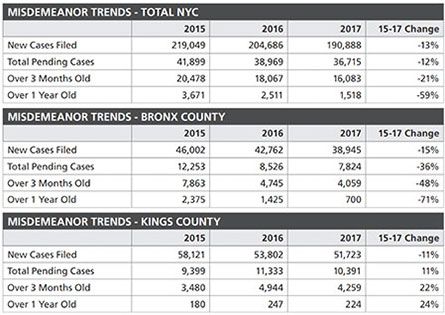
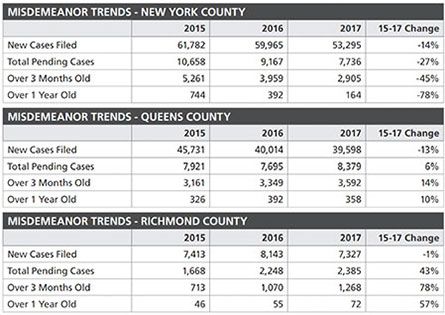
The NYS DCJS offers more than administration for courts and law enforcement. They also serve to protect and inform the public at large, and to that end provide a number of supplementary services through their website, so of which are available through third party websites. New initiatives are offered, in detail, and written in a simple and concise manner under their programs page. Using a sex offender registry can be a difficult task, but DCJS offers step by step instructions on how to access the list, find an address, and identify a sex offender. Concerned citizens can even look up inmates that have been entered into the statewide database providing they know which correctional facility the inmate is kept at, and fill out the necessary form. Former inmates and offenders can even apply for clemency through the state’s website. After reading the step by step instructions on what pardons and clemency accomplish, those wishing to apply must fill out a standard pardon form, and a pardon for convictions at 16 & 17 form. Then, return those forms to the NYS Executive Clemency Bureau.
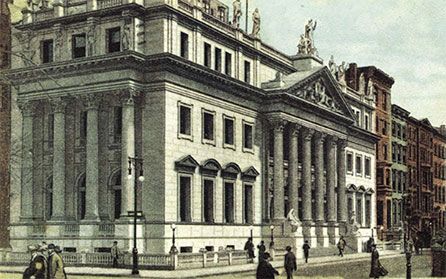
New York Supreme Court, Appellate Division, First Department Read
Historically, New York State was presided over by county-based Supreme Courts which oversaw the network of inferior courts across the State. The constitution of New York changed this in 1846, beginning with the abolishment of the Court for the Correction of Errors, with the jurisdiction transferring to the newly founded Court of Appeals in 1987. The Court of the Chancery was also abolished; their power transferred to the Supreme Court.
 Fulton County Courthouse
Fulton County Courthouse
The oldest courthouse in New York State still stands today. Fulton County Courthouse, in Johnstown, NY, was first built in 1772 at the behest and funding of Sir William Johnson, an Irish official acting on behalf of the British Empire. The first justices of the court were Johnson’s own son, Sir John Johnson, and American Loyalist John Butler. Both justices would operate Loyalist brigade during the American War of Independence. The courthouse still operates as such today, though its modern name was given in 1838 after Fulton County was founded.
